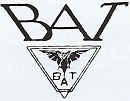|
|
|
|
British Aerial Transport
 British Aerial Transport Co. Ltd.
The British Aerial Transport Company
was founded in June 1917 by Samuel (later Lord) Waring (b. 19 April 1860 in Liverpool, Lancashire, – d.
9 January 1940 in London), chairman of Waring and Gillow. The new company took over the Hythe Road, Willesdon, premises previously
occupied by the Joucques Aviation Company. Waring hired several talented Dutchmen to run his enterprise: chief designer was
Frederick Koolhoven (b. 11 January 1886, Bloemendaal, the Netherlands – d. 1 July 1946, Haarlem, the
Netherlands), formerly with Sir W. G. Armstrong, Whitworth & Company Ltd, assisted by Robert Bernard Cornelis Noorduyn (b. 6 April 1893, Nijmegen, the Netherlands – d. 22
February 1959, South Burlington, Vermont) as Chief Draughtsman, along with Tony van Laar as Chief Engineer. Peter Legh (b.
4 September 1896 in Kensington, London– d. 3 May 1919 in East Finchley, Middlesex), also previously with Armstrong
Whitworth and Co., was appointed test pilot. Koolhovens first design for the new company was the BAT F.K.22 Bat, a
small single-seat fighter. Failure of the ABC Mosquito engine for which it was designed resulted in a new and smaller aircraft
being created, the F.K.23 Bantam, powered by the ABC Wasp, which commenced flight tests in 1918. Only nine production aircraft
were built, and none saw service. 1918 also saw the F.K.24 Baboon and F.K.25 Basilisk fly and it was in one of the latter
that Peter Legh was to lose his life. Also during 1918 George Dowty became a draughtsman with B.A.T. before leaving to join
the design office of the A. V. Roe & Company at Hamble. The first day after the armistice was signed in 1918 Koolhoven started working at the drawings of the
F.K.26., the first time in history that an aircraft had been specifically designed for commercial aviation. Legh’s successor
as chief test pilot, Squadron Commander Christopher Draper, DSC, Croix de guerre (b. 15 April 1892 in Bebington, Chesire
– d. 16 January 1979 in Camden, London), whose penchant for flying under bridges had earned him the nickname "the
Mad Major", piloted the first flight of the F.K.26. in April 1919. With Draper as the pilot and Frederick
Koolhoven as one of the passengers, the second F.K.26, was flown to Amsterdam to be demonstrated at the ELTA, the first Dutch
aviation exhibition of August 1, 1919. Following ELTA saw the inauguration of COBOR, an airline cooperation between Frederick
Koolhoven and the Dutch lieutenant L. Coblijn. COBOR started a weekly service Londen- Hounslow to Amsterdam-Soesterberg in
September 18, 1919, but by the winter of 1919 COBOR were forced out of business. Following successful experimental
use of the F.K.26 over a Hounslow – Le Bourget route, and several charter trips to France, Belgium and Holland, B.A.T
opened a transport office at 38 Conduit Street, W.1, managed by Major John “Jack” Clifford Savage (b.
23 October 1891 in Ryde, Isle of Wight - d. 17 September 1945), later of Skywriting fame, who controlled the
business end of a regular weekly passenger and freight services. On 30 September, 1919, B.A.T. inaugurated a short-lived
domestic airline service between London and Birmingham and on 7 October 1919 another between Hendon and Amsterdam. It was
during this period that Alan Cobham had landed a brief job scouting potential airfields. This was however, short-lived, and
in April 1919 he combined forces with Fred and Jack Holmes to form the Berkshire Aviation Company. Although the fourth
FK.26 was the last aircraft to be built by B.A.T, two more designs had previously been produced. The F.K.27 of June 1919 was
a side-by-side, two-seat variant of the Bantam and the F.K.28 Crow of July the same year was a Demoiselle-style ultra-light.
In 1919 Lord Waring reduced his aviation interests and this forced the closure of the company, its assets being distributed
between Alliance Aeroplane Company Ltd. and Nieuport & General Aircraft Company, the latter also founded by Samuel Waring. Frederick Koolhoven returned to the Netherlands to found his own company, while
Robert Noorduyn also returned there and found work with Anthony Fokker. Since Fokker wanted to expand into the USA, the company
sent Noorduyn in 1921 to Teterboro to supervise a new manufacturing plant. Jack Savage, after a brief stint with Flight as
a journalist, formed the Savage Skywriting Co. Ltd. Company References
Total B.A.T. Production 25
Total B.A.T. Cancelled Orders 9 |
||||||||||||||||||||||||||||||||||||||||||||||||||||||||||||||||||||||||||||||||||||||||||||||||||||||||
|
V1.4.4 Created by Roger Moss. Last updated August 2020 |




























